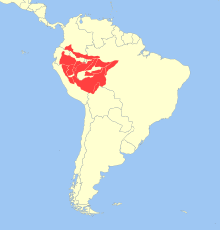Brown-mantled tamarin
| Brown-mantled tamarin[1][2] | |
|---|---|
 | |
| In Tambopata Park | |
| Scientific classification | |
| Kingdom: | Animalia |
| Phylum: | Chordata |
| Class: | Mammalia |
| Order: | Primates |
| Family: | Callitrichidae |
| Genus: | Saguinus |
| Species: | S. fuscicollis |
| Binomial name | |
| Saguinus fuscicollis (Spix, 1823) | |
 | |
| Geographic range | |
The brown-mantled tamarin (Saguinus fuscicollis), also known as the saddleback tamarin or the Andean saddle-back tamarin, is a species of tamarin from South America. It is found in Bolivia, Brazil, Colombia, Ecuador, and Peru.[3]
The brown-mantled tamarin is sympatric with the pygmy marmoset, sharing the same habitat in South American counties, and will often raid the gum holes of this species.[4]
Brown-mantled tamarins occupy an extensive area of northern Amazonia.[5]
Subspecies
- S. f. avilapiresi, Avila Pires' saddle-back tamarin
- S. f. cruzlimai, Cruz Lima's saddle-back tamarin
- S. f. fuscicollis, Spix's saddle-back tamarin
- S. f. fuscus, Lesson’s saddle-back tamarin
- S. f. illigeri, Illiger's saddle-back tamarin
- S. f. lagonotus, Red-mantle saddle-back tamarin
- S. f. leucogenys, Andean saddle-back tamarin
- S. f. mura, Mura's saddleback tamarin
- S. f. nigrifrons, Geoffroy's saddle-back tamarin
- S. f. primitivus, Lako's saddleback tamarin
- S. f. weddelli, Weddell's saddle-back tamarin
References
| Wikispecies has information related to Brown-mantled Tamarin |
| Wikimedia Commons has media related to Brown-mantled Tamarin. |
- ↑ Groves, C.P. (2005). Wilson, D.E.; Reeder, D.M., eds. Mammal Species of the World: A Taxonomic and Geographic Reference (3rd ed.). Baltimore: Johns Hopkins University Press. p. 134. ISBN 0-801-88221-4. OCLC 62265494.
- ↑ Rylands AB & Mittermeier RA (2009). "The Diversity of the New World Primates (Platyrrhini)". In Garber PA, Estrada A, Bicca-Marques JC, Heymann EW & Strier KB. South American Primates: Comparative Perspectives in the Study of Behavior, Ecology, and Conservation. Springer. pp. 23–54. ISBN 978-0-387-78704-6.
- 1 2 Rylands, A. B. & Mittermeier, R. A. (2008). "Saguinus fuscicollis". The IUCN Red List of Threatened Species. IUCN. 2008: e.T39947A10295229. doi:10.2305/IUCN.UK.2008.RLTS.T39947A10295229.en. Retrieved 11 January 2018.
- ↑ de la Torre, S. & Rylands, A. B. (2008). "Cebuella pygmaea". The IUCN Red List of Threatened Species. IUCN. 2008: e.T41535A10493764. doi:10.2305/IUCN.UK.2008.RLTS.T41535A10493764.en. Retrieved 11 January 2018.
- ↑ Mittermeier, Russell A; Nagle, C. A; Dixson, Alan F.; Epple, Gisela; Dukelow, W. Richard; Hearn, John P. (1983). Reproduction in New World Primates: New Models in Medical Science. Springer Netherlands. p. 12. ISBN 978-94-009-7322-0.
Further reading
- Dunbar (1995). "The mating system of callitrichid primates: II. The impact of helpers." Animal Behaviour, 50: 1071–1089.
- Goldizen (1987). "Facultative polyandry and the role of infant-carrying in wild saddle-back tamarins (Saguinus fuscicollis)." Behavioural Ecology and Sociobiology, 20: 99-109.
- Goldizen (1989). Social relationships in a cooperative polyandrous group of tamarins (Saguinus fuscicollis). Behavioural Ecology and Sociobiology, 24: 79-89.
This article is issued from
Wikipedia.
The text is licensed under Creative Commons - Attribution - Sharealike.
Additional terms may apply for the media files.
